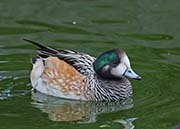Chiloe Wigeon - Anas sibilatrix
| Length | |
| Wingspan | |
| Clutch Size | |
| Chicks at birth | |
| IUCN Conservation Status | |
Continents: |
The Chiloe Wigeon is a South American dabbling duck. The adult sexes are similar in appearance but the female may be a little duller. Juveniles plumage are dull.
Chiloe Wigeons have a black and greenish head and neck while the cheeks and front of the face face white. The belly and rump are whitish. The sides of the body are chestnut colored and the back and chest are patterned in black-and-white. The bill is bluish gray with a black point.
Diet: Chiloe Wigeons eat aquatic plants and grasses and sometimes coastal algae.
Courtship: Chiloe Wigeon are believed to have a long-term pair-bond and are monogamous during the breeding season. In South America, their breeding season is between September and December.
Nesting: Nests are built in grasses and under bushes. The female lays 8-10 eggs. Both parents feed and raise the ducklings.
Habitat and Range: The Chiloe Wigeon prefers freshwater lake, marshes, lagoons and slow moving rivers. They are found in Argentina, Uruguay, Chile, Chile's Chiloe Island, the Falkland Islands and in Brazil during the winter.
Vocalization: The male has a three-syllabled whistle and the female gives loud honks or a low growl.
Plumage/Molt Chiloe Wigeons do not have an alternate (breeding plumage) and probably molt annually.
Migration: Chiloe Wigeons will migrate to Brazil for the winter.
Their legs and feet are gray with the feet webbed.
Bibliography:
- http://en.wikipedia.org The Free Encyclopedia, Accessed July, 2012
- Kear, Janet, ,Ducks of the World
- http://arkive.org Arkive: Images of life on earth, Accessed July, 2012





